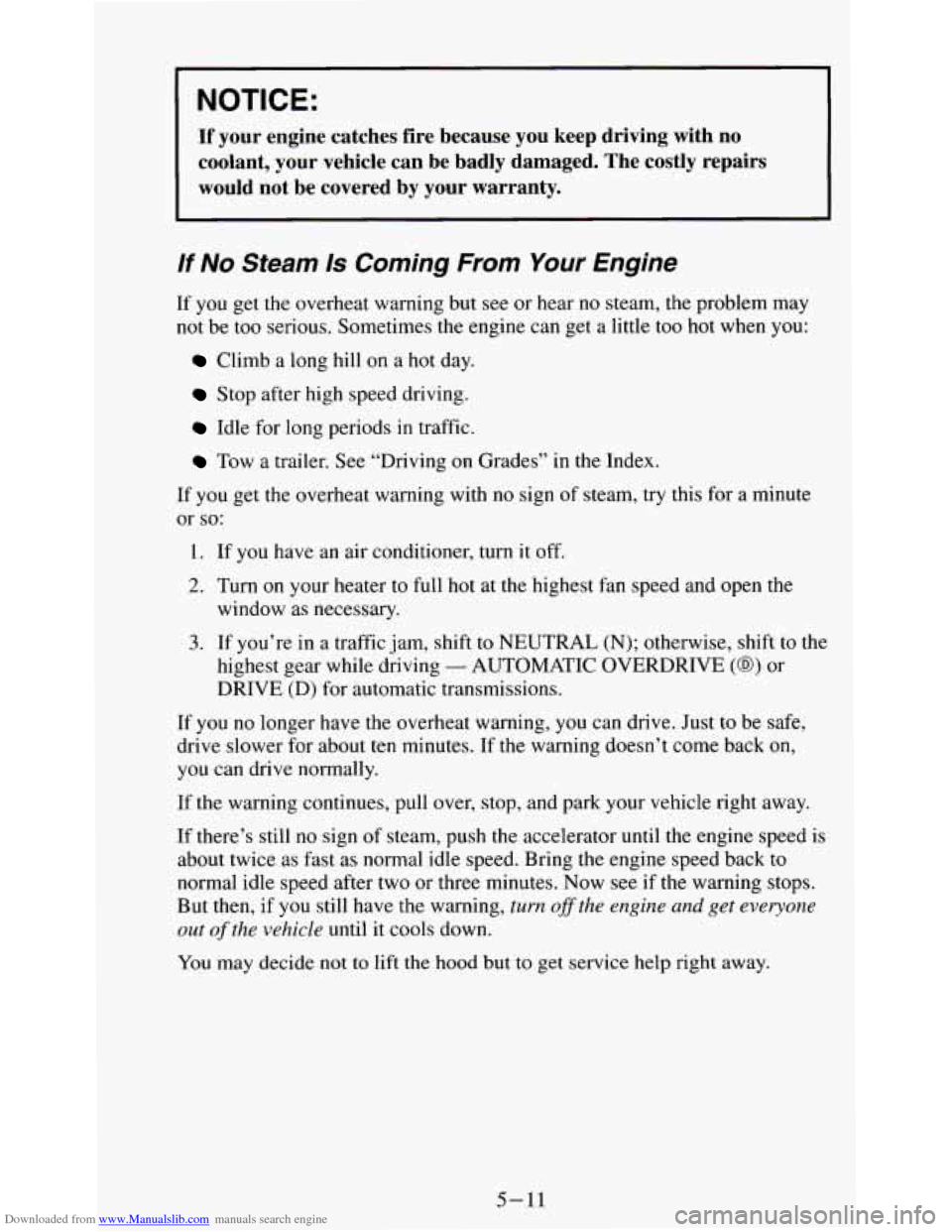Page 61 of 354
Downloaded from www.Manualslib.com manuals search engine 4.3 Liter
A. Engine coolant heater cord strap
B. Engine coolant heater cord cap
In very cold weather,
0°F (-1 8 "C) or colder, the engine coolant heater can
help. You'll get easier starting and better fuel economy during engine
warm-up. Usually, the coolant heater should be plugged in a minimum
of
four hours prior to starting your vehicle.
To use the coolant heater:
1. Turn off the engine.
2. Open the hood and unwrap the electrical cord.
3. Plug it into a normal, grounded 1 10-volt outlet.
A CAUTION:
.,.. ~ , . .. , ...;_ .. ,
Plugging the cord into an ungrounded outlet could cause an
electrical shock. Also, the wrong kind
of extension cord could
overheat and cause a fire. You could be seriously injured. Plug
the cord into
a properly grounded three-prong 110-volt outlet.
If the cord won't reach, use a heavy-duty three-prong extension
cord rated for at least
15 amps.
2- 16
Page 186 of 354

Downloaded from www.Manualslib.com manuals search engine NOTICE:
Ignoring these steps could result in costly damage to your
vehicle that wouldn’t be covered by your warranty.
Trying to start your vehicle by pushing or pulling
it could
damage your vehicle, even if you have a manual transmission.
And if you have an automatic transmission, it won’t
start that
way.
To Jump Start Your Vehicle;
1. Check the other vehicle. It must have a 12-volt battery with a negative
ground system.
NOTICE:
If the other system isn’t a 12-volt system with a negative
ground, both vehicles can be damaged.
2. Get the vehicles close enough so the jumper cables can reach, but be
sure the vehicles aren’t touching each other. If they are, it could cause
a
ground connection you don’t want. You wouldn’t be able to start your
vehicle, and the bad grounding could damage the electrical systems.
You could be injured if the vehicles roll. Set the parking brake firmly
on each vehicle. Put an automatic transmission in
PARK (P) or a
manual transmission in NEUTRAL (N). If you have
a
four-wheel-drive vehicle with a manual transfer case shift lever, be
sure the transfer case is not in NEUTRAL
(N).
3. Turn off the ignition on both vehicles. Turn off all lights that aren’t
needed, and radios. This will avoid sparks and help save both batteries.
And it could save your radio!
NOTICE:
If you leave your radio on, it could be badly damaged. The
repair wouldn’t be covered by your warranty.
4. Open the hoods and locate the batteries. Find the positive (+) and
negative
(-) terminals on each battery.
5-3
Page 194 of 354

Downloaded from www.Manualslib.com manuals search engine If your engine catches fire because you keep driving with no
coolant, your vehicle can be badly damaged. The costly repairs \
would not be covered by your warranty.
If No Steam Is Coming From Your Engine
If you get the overheat warning but see or hear no steam, the problem may
not be too serious. Sometimes the engine can get a little too hot when you:
Climb a long hill on a hot day.
Stop after high speed driving.
Idle for long periods in traffic.
Tow a trailer. See “Driving on Grades’’ in the Index.
If you get the overheat warning with
no sign of steam, try this for a minute
or
so:
1. If you have an air conditioner, turn it off.
2. Turn on your heater to full hot at the highest fan speed and open the
window as necessary.
3. If you’re in a traffic jam, shift to NEUTRAL (N); otherwise, shift to the
highest gear while driving
- AUTOMATIC OVERDRIVE (0) or
DRIVE
(D) for automatic transmissions.
If
you no longer have the overheat warning, you can drive. Just to be safe,
drive slower for about
ten minutes. If the warning doesn’t come back on,
you can drive normally.
If the warning continues, pull over, stop, and park your vehicle right away.
If there’s still no sign of steam, push
the accelerator until the engine speed is
about twice as fast as normal idle speed. Bring the engine speed back to
normal idle speed after two or three minutes. Now see
if the warning stops.
But then, if
you still have the warning, turn ofSthe engine and get everyone
out of the vehicle until it cools down.
You may decide not to lift the hood but to get service help right away.
5-11
Page 223 of 354
Downloaded from www.Manualslib.com manuals search engine Checking Things Under the Hood
To open the hood, first
pull the handle inside
the vehicle on the
lower driver’s side
of
the instrument panel.
Then
go to the front of
the vehicle and release
the secondary hood
release.
Lift the hood, release
the hood prop from its
retainer and put the
hood prop into the slot
in the hood. You will
have
an underhood
light that comes
on
when you lift the
hood.
6-6
Page 249 of 354
Downloaded from www.Manualslib.com manuals search engine Composite Headlamps
1. Open the hood.
2. Remove the black
protective caps
from the removal
pins at the
top of
the radiator
support. Use a
hex socket
to
unscrew pins.
3. Pull the headlamp
lens assembly
out. (Some
vehicles may
have side by side
bulbs.)
4. Unplug the
electrical
connector.
5. Turn the bulb
counterclockwise
to remove it.
6-32